Trends among Graduates of Canada’s Art & Design Universities
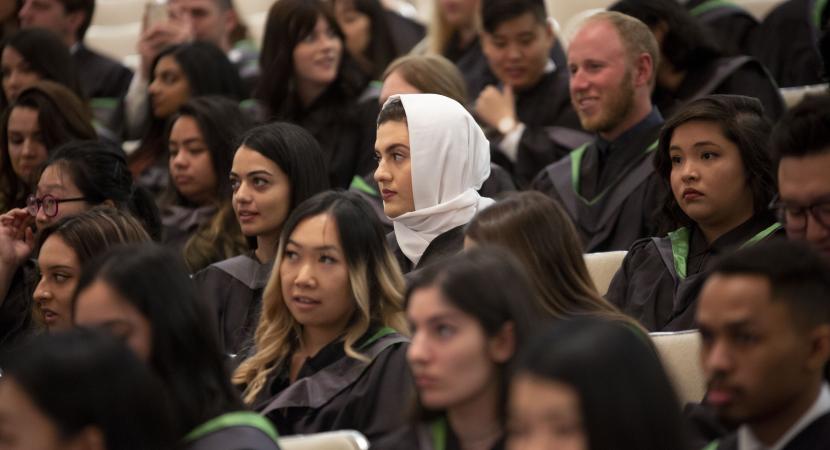
Introduction
This data brief explores an aggregate report that was created from the 2015-17 Strategic National Arts Alumni Project (SNAAP). The SNAAP collects, analyzes and shares survey data that offers insight into the professional success, educational satisfaction and personal fulfillment of recent graduates and alumni of post-secondary art and design programs.1 Since 2008, alumni from participating North American arts institutions have had the opportunity to respond to the SNAAP survey to describe their educational experiences and ensuing careers.
Securing access to this 2015-17 SNAAP report provides the opportunity to investigate new data that looks at how artists and arts workers from Canadian institutions are faring professionally since they graduated. Until now, our understanding of the trends in graduates’ successes and challenges in the professional arts and culture sector has been limited and largely informed by anecdotal evidence and the experiences of alumni from individual institutions. The statistical data available from arts councils and foundations, the Government of Canada and independent research firms provides some insight into overall sector trends, but it has not yet placed a specific lens on the post-graduation experiences of individuals who have studied and trained in arts institutions.
This report provides a corrective to this data gap by shedding light on who the graduates of Canadian arts institutions are, where they work, and how they work. Overall, this brief highlights the complex working arrangements of emerging arts professionals from Canadian institutions and invites further questions on how their experiences can inform policy decisions around arts education and work in Canada.
Data
The SNAAP report—the first Canadian dataset of its kind—encompasses data from undergraduate and graduate alumni from five Canadian creative institutions: NSCAD University, OCAD University, Alberta College of Art + Design, University of Victoria, and Emily Carr University of Art and Design. It illuminates the extent to which arts alumni from Canadian institutions are finding professional success. This report includes responses from nearly 4,900 undergraduate respondents included in the 2015, 2016, and 2017 Canadian Aggregate SNAAP Report.
The SNAAP report captures alumni responses to survey questions about what they studied, the creative and professional skills they developed during their time at the arts institution, and their overall satisfaction with their educational experience. Additionally, the survey captured alumni’s career opportunities and choices since leaving school, the conditions in which they find themselves working, the professional skills they need to succeed in their work and where their artistic practice fits into their professional and/or personal lives.
Data demographics
The respondents represent people who graduated as far back as 1987, with the most recent alumni graduating in 2017, and the majority having graduated between 2008 and 2017, as shown in Figure 1.
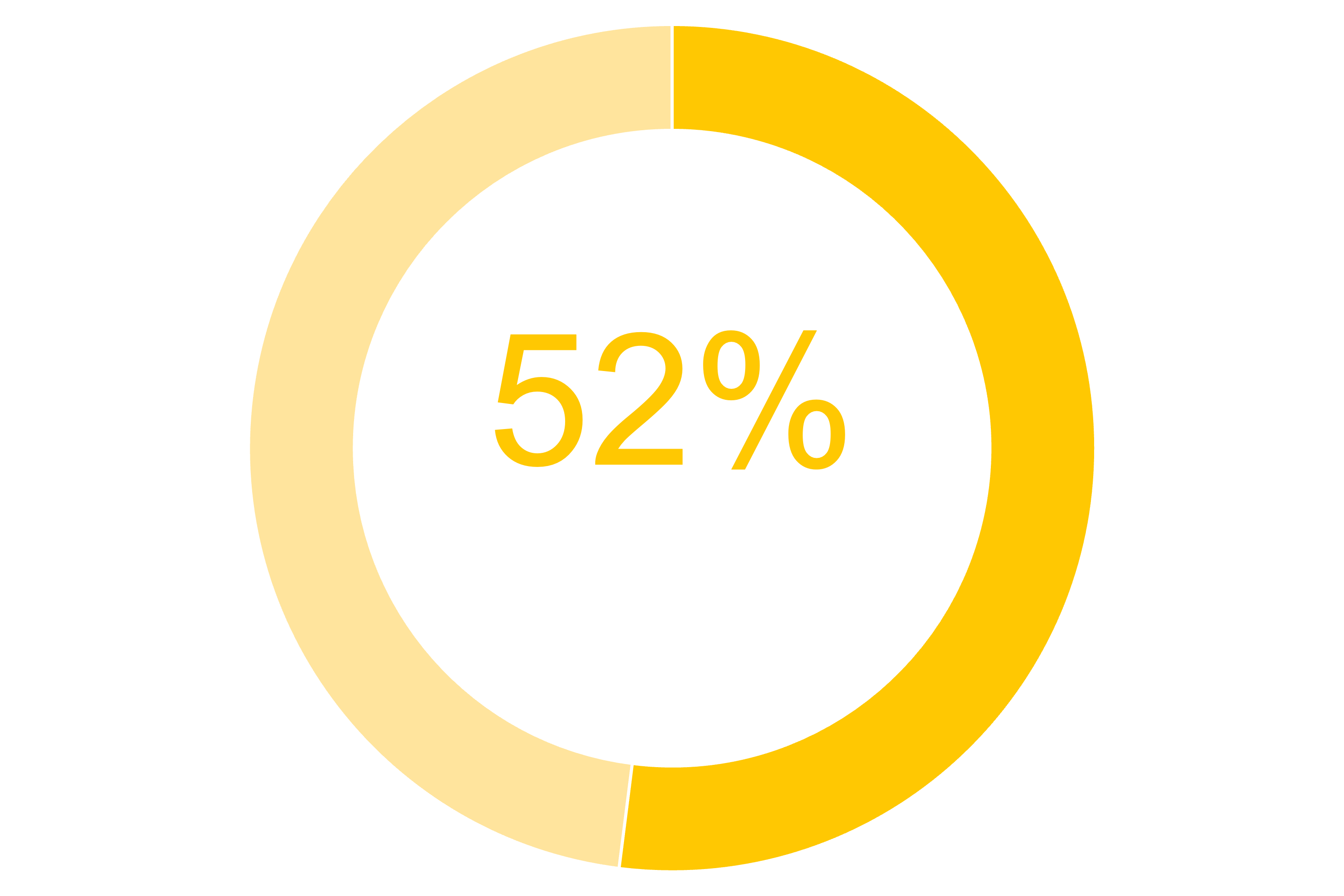
The data demonstrates the experiences of graduates at different stages of their careers—from recent graduates who are just now beginning their careers to people who have been navigating the professional creative sector for over 30 years.
Data limitations
The demographic data provided by respondents reveals significant gaps in the dataset. Just over two-thirds of respondents self-identify as women or another gender, while 29% identify as men. The majority of respondents are aged between 25 and 39 years old, suggesting that most are either emerging or mid-career professionals in their respective fields. Critically, 81% of the respondents self-identify as white, showing the limitations of the dataset.
In addition, the Cultural Policy Hub research team only had access to aggregate data.
Finally, the data were from the 2015, 2016, and 2017 Canadian Aggregate SNAAP Report, which captures a time before COVID.
Data Trends
The Cultural Policy Hub’s research team scanned the aggregate report for descriptive data that relate to key areas of interest, including: the speed and ease of alumni’s transitions from post-secondary training to work; alumni’s ability to find sustainable work within their given fields; alumni’s ability to sustain an artistic practice related to their discipline of study; alumni’s experience of training leading to high career satisfaction; and alumni’s current needs to thrive in their work. Also included are insights from the Creative Independent’s 2018 report A Study on the Financial State of Visual Artists Today that amplify some of the SNAAP findings.
Educational experience
What is it exactly that these respondents studied? Chart 1 below breaks down the areas of focus among respondents, which shows a range of creative subjects.
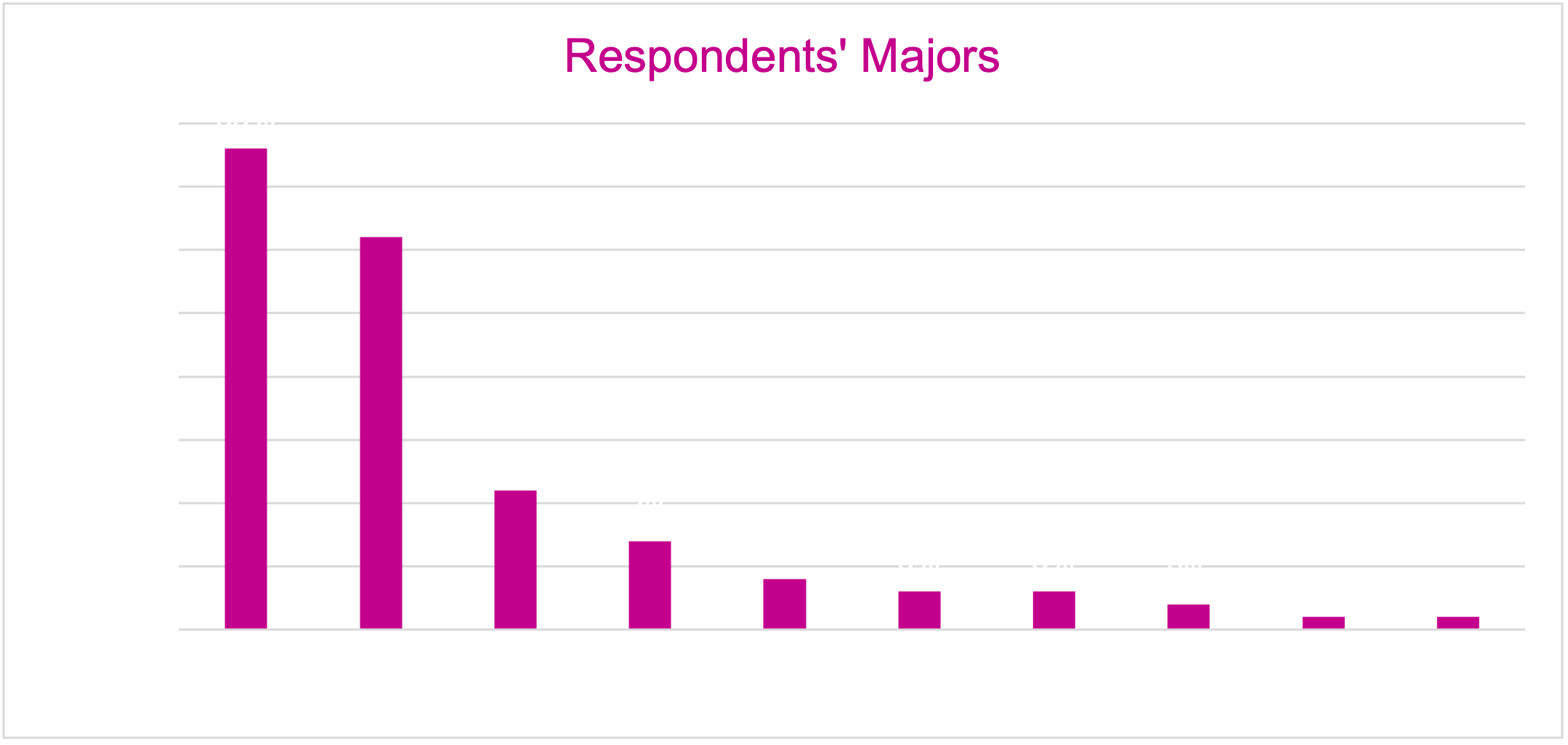
In addition, respondents were asked if they intended to eventually work in an occupation as an artist when they began their studies. An unsurprising majority (83%) responded “Yes”.
The data drills down into rates of satisfaction for students across several factors relating to their time at the institution, including the academic environment, opportunities to explore artistic practices outside their majors, the development of critical skills, and exposure to a diverse community of students and collaborators. Despite the wide range of experiences throughout the group of respondents, with some less positive than others, the majority of respondents rated their overall experiences in these programs as either Good (47%) or Excellent (36%), with 80% saying they would recommend the institution they attended to a prospective student like themselves.
Transition from school to work
Among respondents who found work after graduation, 71% were able to do so within a year of graduation as illustrated in Figure 2 below.

The majority of respondents found work either before completing their program or within four months of graduating. Of those who didn’t find work after leaving the program, 16% either pursued further education (12%) or did not look for work upon graduating at all (4%), as shown in Chart 2 below, which indicates a successful transition from school to the labour market.
Geographically, just over half of the respondents (53%) pursued the first five years of their career in the city where they studied.
Of importance, the data revealed that the relevance between what graduates studied and the work they eventually found is not guaranteed, but very likely. Nearly seventy percent of the respondents reported that their first job following post-secondary education was closely or somewhat related to their field of study, as shown in Chart 3.
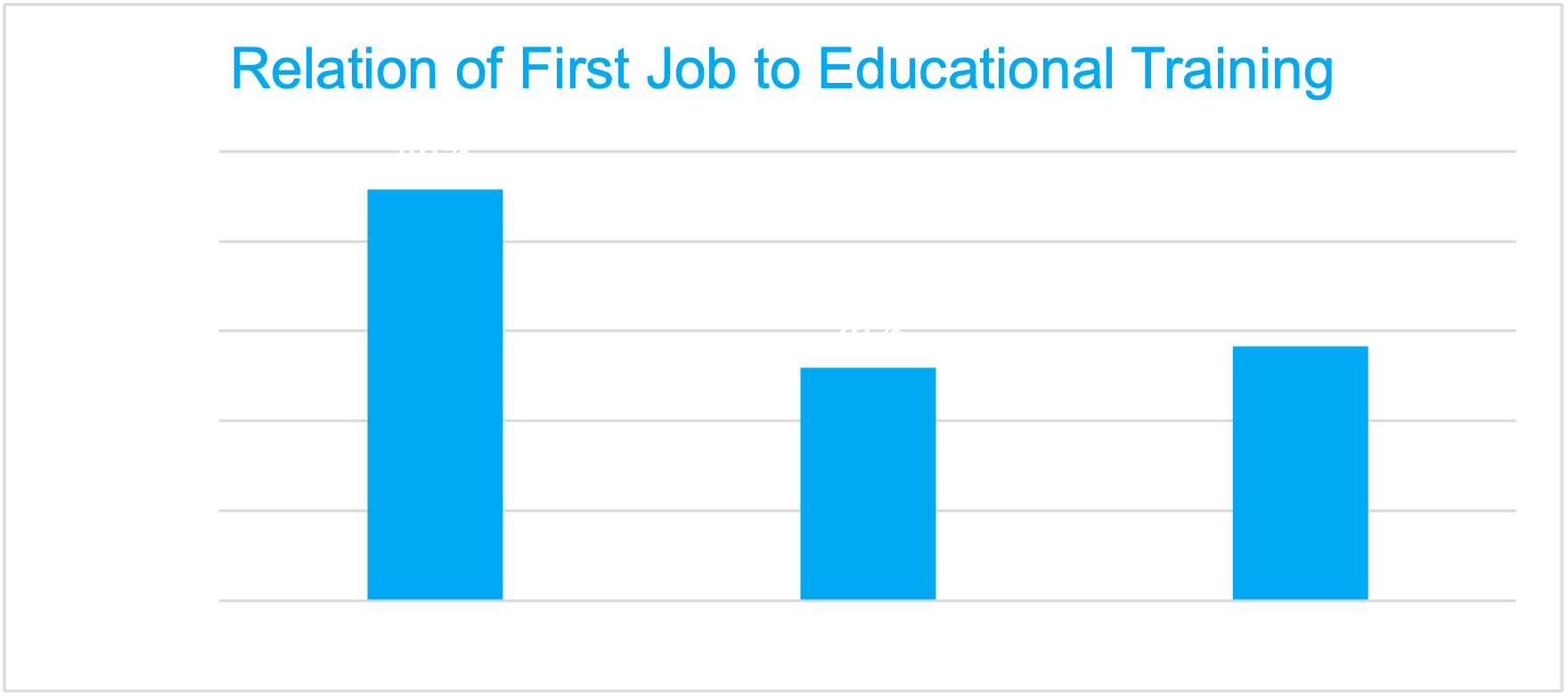
Roughly a quarter felt their first job was somewhat related, while 28% reported their first job was not related. It is telling that the majority of respondents either had to find work in a somewhat related field or cultural discipline or accept opportunities outside of their field of study as a first step in establishing their career. The data also revealed that 55% of respondents who worked as artists explored other disciplines outside their choice discipline of study, which suggests a high degree of flexibility and creative curiosity among the respondents. This also indicates a high degree of potential benefit—creative or otherwise—to a cross-disciplinary approach to developing an artistic practice.
Chart 4 below shows the fields that graduates work in, which largely corresponds to their fields of study. A notable exclusion here is that of media arts graduates, who made up the third largest group of student majors (see Chart 1) and are less clearly captured in the “Occupations” data. Respondents were asked to report their current occupations as well as the occupations in which they have spent the majority of their work time.
The responses below highlight a contrast between respondents’ current occupations and main occupations (in terms of work time spent). This contrast supports the notion that emerging artists experience complex working arrangements, as many must juggle working multiple jobs.
These data raise interesting questions about the nature of arts education. The opportunity for students to specialize should accompany opportunities to pursue interdisciplinary training that prepares students to be adaptable to the prospects for work available to them after graduating. It also implies the relevance of creative skills to many sectors or jobs. As will be seen, other data indicate that those graduates who are left to accept work outside of their given field end up nurturing creative practices outside of their full- or part-time work.
Work arrangements and conditions
The report provides insight into how and where arts graduates are working.
Among those respondents who pursued work related to their training as artists, the majority pursued careers in graphic design and the fine arts. This is an unsurprising outcome given the popularity of these disciplines among the majors students pursued (see Chart 4). 27% of other respondents situated their careers in alignment with other direct creative practices, such as crafts, photography, and writing, while 15% worked in education and/or communications.
When asked whether they had ever worked—either full- or part-time—in an occupation as an artist, 55% of respondents reported that they currently did, 18% reported that they have in the past but do not currently, and 27% reported they have not. The evidence that two thirds of respondents had found some success in developing an artistic practice is tempered by the fact that, among that group, only 30% spent more than half of their working time on their artistic practice. Furthermore, 57% of SNAAP undergraduate respondents reported that half or less of their personal income came from work as an artist in the previous calendar year, as shown below.
Leaving work in the arts
Nearly a third of respondents have never actually worked as an artist. This data point aligns interestingly with the 16% of respondents who stated they did not attend a creative school with the intention of becoming practicing artists. The reasons given by respondents who previously worked as artists but stopped, or who never pursued an artistic practice as part of their career, offer insight into the challenges that can compound or create barriers for creative school graduates entering the job market as emerging artists and creative professionals.
Chart 5 shows reasons why graduates left working in the arts.
Financial reasons, including seeking higher pay and steadier income, availability of work and debt load were main factors. Other cited reasons include lack of access to networks and changing interests.
Artist entrepreneurs
As show in Figure 4, the majority of undergraduate respondents within the sample are either currently (48%) or were previously (32%) self-employed or have worked as independent contractors or freelance workers. This illuminates that most arts alumni engage in entrepreneurial work at some point in their careers. Similar findings are apparent in the Creative Independent’s 2018 report, which highlights that 61% of their artist survey respondents engage in freelance work.

Notably, nearly half (42%) of artist respondents to the Creative Independent’s survey reported that they have multiple jobs.3 The Creative Independent also found that most respondents treat art as a part-time job, with only 10% indicating they devote 40 or more hours a week to creating art.4 In fact, almost half of the respondents to the Creative Independent’s survey stated that 10% or less of their income was generated from their artistic work.5 How artists balance their creative work and other income-generating work is an area worthy of further exploration.
The extent to which these respondents are thriving in largely contract and freelance roles is less clear: while 73% report being “Somewhat” or “Very Satisfied” with the job security they enjoy, the precarity of work across the arts and culture sector has been a topic of intense focus and debate in Canada, with anecdotal evidence suggesting that much more needs to be done to ensure that artists are properly supported and fairly compensated for their labour.
Career satisfaction
Overall, 85% of the sample reported being satisfied with the occupation in which they currently spend the majority of their work time (38% reported they are very satisfied and 47% reported they are somewhat satisfied).

Specifically, respondents who were employed at the time of the survey reported being very satisfied with the following aspects of their current occupation:
- work reflects personality, interests, and values (47%);
- opportunity to be creative (41%);
- job security (38%);
- opportunity to contribute to the greater good (37%);
- balance between work and non-work life (29%);
- opportunity for career advancement (26%);
- and income (24%).
Art in personal time
Altogether, this survey reveals a clear and sustained passion for arts and design among the sample, as 79% reported that they make or perform art in their personal time. When asked how often they make/perform art in their spare time, 19% stated a few times a year or less, 34% stated several times a month, 28% stated several times a week and 19% stated daily. However, low rates of satisfaction with income, opportunities for career growth, and work-life balance suggest that artists’ needs for resources, funding, and capacity-building tools are not necessarily being met.
Career needs
Respondents were given an opportunity to identify resources needed to advance their artistic career but to which they currently don’t have access.
Specialized professional supports in promotion, publicity, and business advising, and the development of professional networks constituted the majority of the needs expressed by respondents. One in five cited access to space to create and exhibit their work as a vital need, with access to financing and professional equipment rounding out the list. The scope of the needs presented is admittedly narrow; it suggests scarcity and the need for greater supports in certain areas but overlooks broader systemic issues related to the funding of artists’ work in Canada, the high cost of living nationwide, and the inequities in the accessibility of space and resources for artists and arts workers.
Summary of key data and next steps
This data brief represents a starting point for a deeper inquiry into the successes and challenges faced by emerging arts professionals who graduated from Canadian art and design post-secondary institutions and programs.
Taken on its own, the data would suggest that the majority of creative sector workers are satisfied with their careers, whether they are working directly as artists or not. Findings highlight that:
1. An arts education prepares artists for a career, though it may be in a different field than their primary area of study: Most graduates were able to transition from school within four months of graduating, but only 45% found work directly related to their field of study.
2. Artists mostly work through a combination of freelance, contract, and part-time roles: A majority of artists have worked as freelancers (73%), and only 30% work as artists for more than half their work time. One third of graduates have never worked as artists.
3. An arts education contributes to high career satisfaction among those surveyed: Despite some obstacles, the vast majority of respondents feel satisfied with their careers, particularly how their work reflects their personality and interests, and the opportunities it provides to be creative.
4. Arts graduates leave work in the arts mainly due to financial reasons: Financial reasons included seeking higher pay and steadier income, availability of work and debt load.
5. Arts graduates have distinct needs for career advancement: Respondents identified areas where they need more support, offering insight into educational and sector-specific resources that can help graduates succeed, including network-building, business advice, and support with promotion and publicity.
Next steps
As the aggregate data represents a pre-COVID context, further exploration is needed to understand how respondents' perspectives may have shifted due to the pandemic and the compounding pressures that artists and creative workers face, including increasing labour precarity, the unaffordability crisis, and the reduction of public supports for the arts in Canada. The outlook that this aggregate data provides would no doubt be very different if it also included perspectives from people who face greater societal barriers to both educational and workplace participation and success.
Since these findings were based solely on aggregated data, the research is limited as are the conclusions that could be drawn from it. This brief presents just a snapshot of the available 2015-17 SNAAP data, which revealed significant demographics gaps. As a next step, more research should be conducted on the raw data to explore further inferential analyses. An additional year of data has now become available, which should provide additional insight into how more recent graduates are faring as they emerge in the field. The research team also has an opportunity to gather data from the team at Fineline, who lead a focus group of recent alumni whose feedback could provide perspectives that include the post-pandemic context.
Fineline is a project of OCAD University with support from Future Skills Centre to incubate the Fineline.art marketplace and a co-operative that helps artists and designers grow their business online, while developing cultural entrepreneurship skills.
- Strategic National Arts Alumni Project | SNAAP. 2023. https://snaaparts.org
- The Creative Independent. 2018. A study on the financial state of visual artists today. https://tci-assets.s3.amazonaws.com/pdfs/artist-survey-report/artist-survey-report.pdf
- The Creative Independent. 2018. A study on the financial state of visual artists today. https://tci-assets.s3.amazonaws.com/pdfs/artist-survey-report/artist-survey-report.pdf
- The Creative Independent. 2018. A study on the financial state of visual artists today. https://tci-assets.s3.amazonaws.com/pdfs/artist-survey-report/artist-survey-report.pdf
- The Creative Independent. 2018. A study on the financial state of visual artists today. https://tci-assets.s3.amazonaws.com/pdfs/artist-survey-report/artist-survey-report.pdf